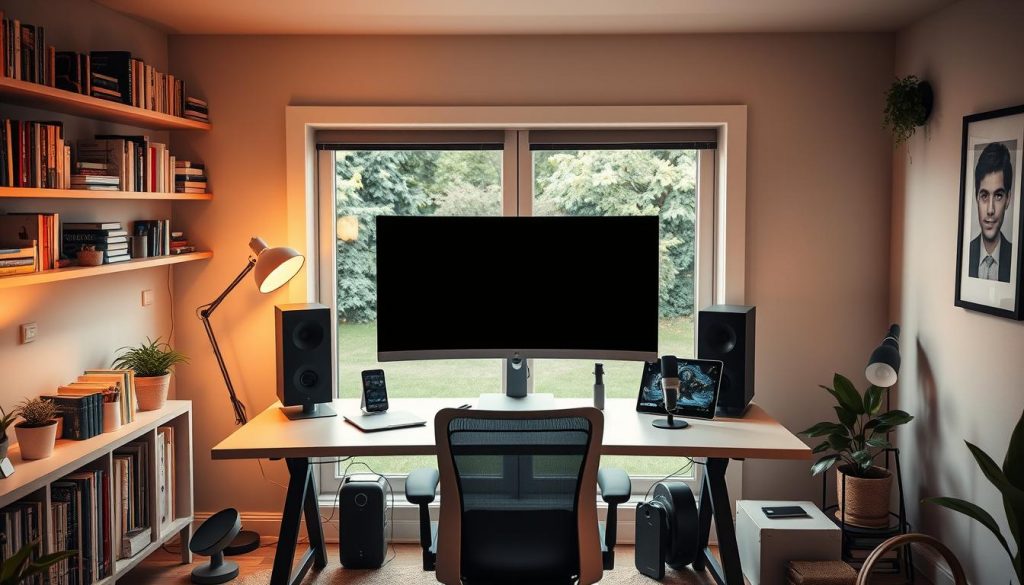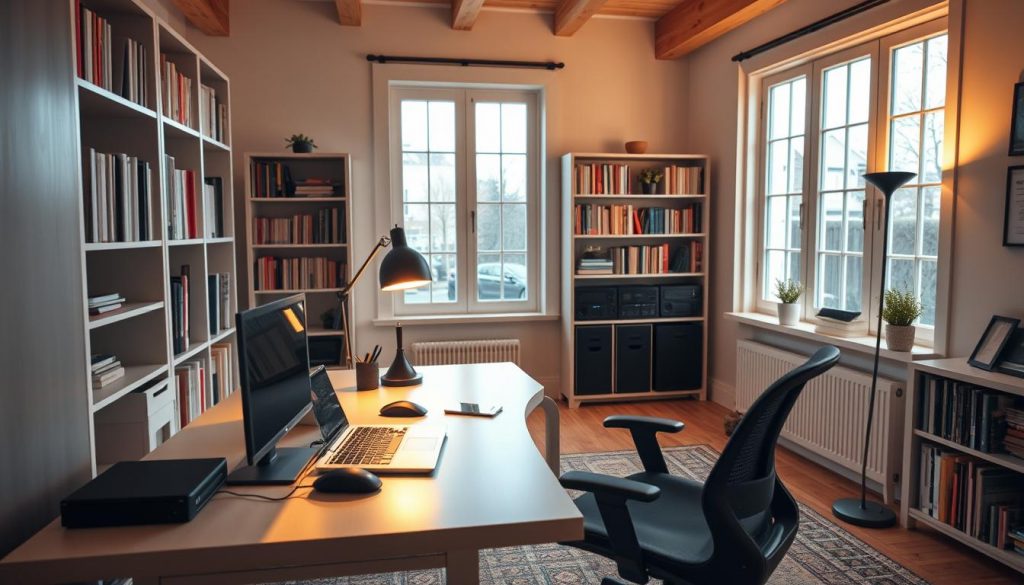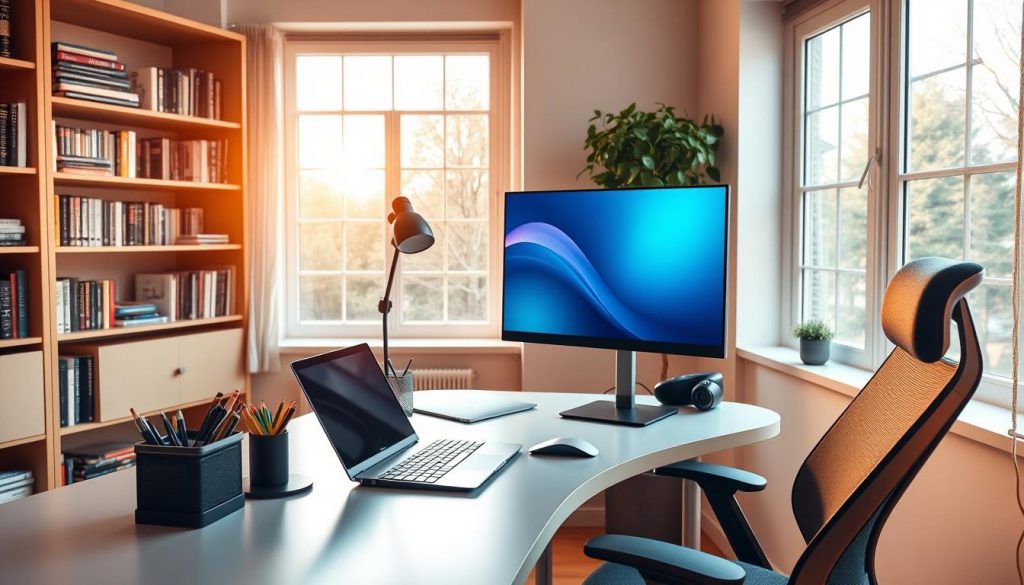How to Create a Tech-Friendly Learning Environment at Home
Students at Conestoga carry about 2.5 devices with them. This shows how much technology affects learning. It motivates you to create a tech-friendly space at home for better learning.
Setting up a tech-friendly learning area at home can help a lot. It improves focus, encourages growth, and makes learning more engaging. You can use tools that help your child succeed in school.

Key Takeaways
- Design an area that keeps your child immersed in meaningful study sessions.
- Encourage device readiness through reminders and organized supply stations.
- Use practical furniture that supports posture and concentration.
- Include interactive digital tools to spark deeper involvement in class material.
- Maintain order to minimize distractions and promote smoother learning routines.
Why a Tech-Focused Setup Matters for Your Child
Creating a dynamic environment that merges creativity and convenience can shape your child’s readiness for digital tasks. Integrating devices for research nurtures independence and boosts collaboration.
In one study, kids aged 11-17 checked phones a median of 51 times daily. Encouraging device usage fosters essential problem-solving skills that extend beyond the classroom walls.
For a tech-friendly learning environment at home, your child gains familiarity with digital tools from Apple or Google.
This exposure builds lasting competence for adapting in academic settings.
+ How to Automate Your Home Lighting for Maximum Comfort

Children who have a dedicated learning space show a 30% rise in focus at home. Cultivating this tech-friendly learning environment at home elevates growth and digital confidence.
Selecting the Best Hardware for Modern Learning Needs and Essential Devices
Choosing the right devices for your child helps create a tech-friendly learning space at home. Laptops, tablets, or smartphones can make learning more engaging.
Studies show that 86 percent of teachers see better student engagement with digital tools. The right devices help with e-books, interactive lessons, and teamwork on various projects.
Laptops and tablets are key for many school subjects. Adding peripherals like printers, headphones, or a Logitech HD Pro C920S webcam makes learning easier and more fun.

Think about getting one-to-one or two-to-one device programs. This helps ensure all students have what they need, leading to better learning and preparation for the future.
Also Read: AI in Education: How Machine Learning Helps Children Learn
Optimizing Wi-Fi and Internet Speed for Seamless Classes
For uninterrupted virtual sessions, you need a strong router. Look for one that supports Wi-Fi 6 or Wi-Fi 6E. These offer powerful tri-band channels and wider coverage for your studies.
Place your router in the middle of your home to cut down on signal interference. Use QoS settings to make sure streaming stays stable. This keeps your learning space tech-friendly and smooth.
Choosing between dual-band or tri-band routers helps manage tasks better. You can use different channels for video chats or group projects. This reduces conflicts on 2.4GHz or 5GHz frequencies.
Some routers come with apps that make setup easy. These apps include guest networks and parental controls. They help keep your learning space safe and secure.
Adding a range extender, like the TP-Link AC1750 for about $37.99, boosts signals. This ensures steady lessons even in bigger areas.
Here are steps to boost your internet speed and keep bandwidth steady:
- Use QoS settings to prioritize educational tasks. This lets video discussions and research projects run smoothly. Downloads can wait on a different band.
- Keep an eye on traffic with router apps. These show bandwidth usage per device. This helps you find fast connections if devices start using too much signal.
Incorporating Ergonomic Furniture and Lighting
Having the right chair can make studying easier by keeping you in the right position. Knoll’s adjustable chairs help with this, providing support for your lower back. They help you stay balanced for hours.
Adjustable desks are great for changing your setup as you work. They help you stay comfortable and focused, keeping your eyes at the right level for screens.
Lighting is key to a good study space. Using lamps and avoiding glare helps you focus better. The right light keeps your eyes from getting tired and helps you stay engaged.
Choose desks and chairs that adjust to your needs. This setup keeps you comfortable, even when you’re studying for a long time. It makes your home study area more tech-friendly.
Digital Tools That Foster Interactive Learning
Introduce online apps to make learning fun and engaging for your child. These tools encourage problem-solving and teamwork. They help build confidence and spark new ideas.
Edmodo has over 34 million users and offers personalized interactions. ClassDojo uses digital badges to promote positive behaviors. This helps create a tech-friendly learning space at home.
Socrative lets you create quizzes on mobile devices. It shows strengths and weaknesses, guiding lesson plans. This keeps every learner challenged in real time.
Prodigy helps students explore math, while Storybird encourages writing stories. cK-12’s open-source platform supports dynamic reading and experimenting with new topics.
Animoto videos and Kahoot! polls make lessons exciting. They turn projects into adventures, fueling a tech-friendly learning environment at home. Students learn to collaborate through real-time documents and virtual labs.
Practical Ways to Maintain Cybersecurity and Privacy
Strengthening cybersecurity at home helps your child develop good digital habits. It keeps their privacy safe when they’re online for school or fun projects. This is important because of COPPA and FERPA rules.
Identity theft was a big problem in 2014, happening every two seconds. Teaching your child to use strong passwords and be careful with clicks is key. It helps keep their personal info safe.
Teach your child about two-factor authentication and checking security settings often. This shows them how important privacy is in our digital world at home.
Start each day by reminding your child of the rules for being online. Use digital citizenship resources to teach them about safe browsing.
This helps them understand how their online actions can shape their future.
Use simple pictures to remind your family about safe online practices. This keeps you all safe and helps you relax when using technology together.
Find a balance between keeping things secure and talking openly about it. This creates a safe space for your child to learn and grow. It lets them explore the digital world without losing sight of privacy.
Establishing Tech-Free Intervals for Balanced Growth
Regular breaks from tech can really help reduce digital fatigue and burnout. Research with 71 participants showed that short breaks can boost well-being.
By setting aside time for offline activities, you create a tech-friendly learning space at home. This lets your child enjoy non-digital hobbies with excitement.
Studies found that writing on physical planners and reading paper books improve understanding.
They help avoid digital overload and boost critical thinking skills across different ages.
The Pomodoro Technique suggests regular device-free breaks every hour. This helps improve focus, encourages movement, and builds strong habits in a balanced study day.
Having gadget-free times at meals or before bed strengthens family bonds. It helps students avoid constant screen time and keeps their minds clear.
A balanced home learning environment supports offline activities, daily movement, and in-person events. These activities keep creativity and motivation alive.
Designing a Multi-Purpose Study Corner, Promoting Healthy Screen Habits, and Conclusion
In a multipurpose study corner, you can mix an open layout, comfy seating, and mindful screen breaks. This setup boosts teamwork and protects your kids’ eyes.
Most kids keep devices in their bedrooms. Leaving them off at night helps your home stay tech-friendly. It also leads to better sleep.
A flexible seat design cuts down on long-term strain. An eye-friendly lamp also keeps screen glare low. This lets you work without neck or shoulder pain.
By combining open layouts and flexible furniture, you create a tech-friendly learning space at home. It sparks digital creativity and helps your kids live a fulfilling life.
